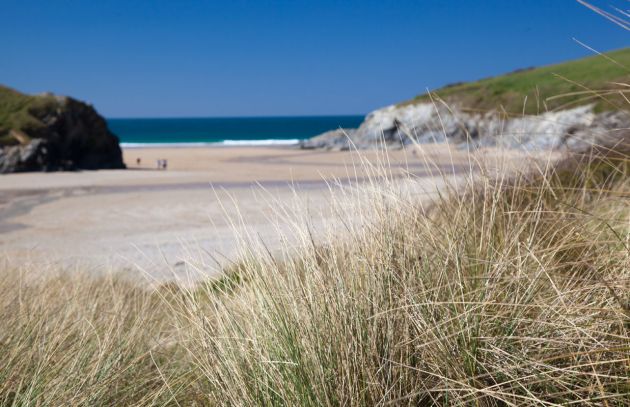The path leaves Newquay from just above the harbour, climbing to Towan Head past an old Huer's hut. The cliffs here are home to a number of species of bird such as Fulmars, Kittiwakes and, further out to sea, Petrels and Shearwaters. After Towan Head comes Fistral, a very straight beach backed by sand dunes nearly 1 km long that could be called the capital of British surfing. Fistral, which can get very crowded in summer, has been the site of major international surfing competitions since the 1980s. The reef between the north headland and the beach is known as the Cribbar and is England's foremost big wave spot. Local surfers have ridden waves here measuring up to 40 feet. Also at the northern end of the beach is the famous Headland Hotel, used as a location in the film of Roald Dahl's 'The Witches'
The path follows along the back of the beach before climbing to the cliffs at the southern end and passing over a headland before descending to the River Gannel, which separates Newquay and Crantock. Seasonal ferries operate across the river, and there is a footbridge at low tide. At other times it is necessary to detour inland and use the road bridge. The Gannel becomes a tidal estuary as it approaches the sea and it is a choice location for migratory birds.
On the other side of the river the path skirts the historic parish of Crantock, which dates back to 460 AD when Irish hermits founded an oratory. Yet another sandy beach backed by dunes. The path heads west through the dunes to Pentire Point West, a Site of Special Scientific Interest owned and managed by the National Trust. Wild flowers and rare plants may be seen.
There follows a sheltered sandy inlet called Porth Joke (Jackdaw Cove) and known locally as Polly Joke. The cove is superbly peaceful and unspoilt, surrounded entirely by National Trust land, and unchanged for centuries.
Over Kelsey Head, with views all the way to St Agnes, and onwards to Holywell Bay. If it is low tide check out a natural cave on the north side of the beach, which contains pools and wells formed by the build-up of natural minerals over thousands of years.
Over Penhale Point, around Penhale Camp (an army training area), out onto Ligger Point and down to another long, sandy beach. At low tide it's best to walk along the beach, although the official path will take you onto the dunes before crossing a stream via a footbridge and entering the village of Perranporth.
Perranporth (Cornish for St Piran's Cove) is home to yet another popular surfing beach which picks up a lot of swell due to the large fetch. There is little between here and North America to break the power of a big swell. The, somewhat overdeveloped, town is named after a lost church believed to have been founded by St Piran in the 7th century before being buried under the sand for hundreds of years. It was unearthed in the early 20th century only to be buried again in the 1970s, although plans exist to unearth it again. It is generally safe to swim on the beach, and there are toilets, cafes, shops, places to stay and even an up-market restaurant currently being developed by Masterchef host, John Torode.
The south end of the beach is backed by dramatic cliffs that have given rise to arresting arches and stacks. The path leads up to a cliff car park at Droskyn Point, where there are spectacular views and a youth hostel.
As the path continues towards St Agnes there is increasing evidence of mining activity. A small granite outcrop at Cligga Head has been quarried and there are various decaying mine buildings in Trevellas Coombe. As you travel the cliff from Perranporth to St Agnes look out for Hanover Cove, named after The Hanover, which was wrecked here in December 1938 on its way from Lisbon to Falmouth with £50m of gold on board, which has never been recovered!
At low tide it is possible to cross the beach from Trevellas Porth to Trevaunance Cove. Otherwise head upstream at Trevellas Coombe, over the bridge by the engine house, over the cliff top (where the path passes excitingly close to the edge) and down to the cove, where there's a seasonal café and the Trevaunance Cove Hotel, with an attractive beer garden and views of the sea











